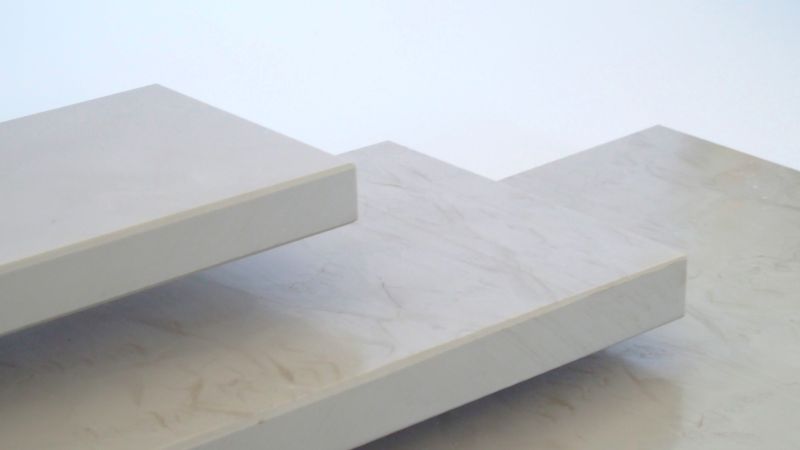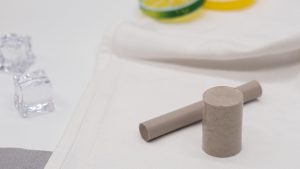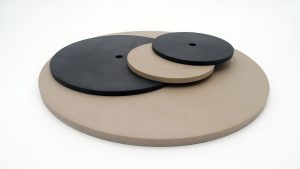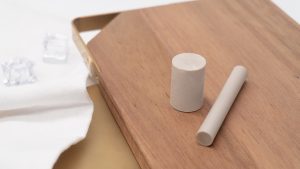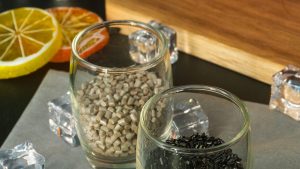Description
QUALITY CHARACTERISTICS
Sheets from PEEK are offered usually extruded and cut in standard lenths. Various sheet thicknesses possible. Our Dexnyl PEEK sheets are made of our own CoPEEK or compounds based on CoPEEK or other conventional brands.
COMMERCIAL CLARIFICATION
Sheets of thicknesses between 10mm and 50mm of PEEK nature but also as reinforced PEEK.
TECHNICAL DATASHEET*
| Legend | |
| 1 | Low |
| 10 | High |
| √ | Applicable |
| x | Not applicable |
| (√) | Limited |
| k.Br. | No break |
| n.d. | Not feasible |
| - | Not determined |
| n.v. | Unavailable |
| Properties | Symbol | Unit | Standard | Value |
| Material code | - | - | Internal Standard | A3A |
| Colour | - | - | - | Beige |
| Density | ρ | kg/dm3 | ISO 1183 | 1,3 |
| Properties | Symbol | Unit | Standard | Value |
| Compressive modulus | Ec | MPa | DIN EN ISO 604 | 4270 |
| Elastic limit | σel | MPa | Internal Standard | 120 |
| Comprssive stress at yield | σY | MPa | DIN EN ISO 604 | n.v. |
| Compressive strength | σM | MPa | DIN EN ISO 604 | n.v. |
| Compressive stress at 3,5% strain | σ3,5% | MPa | DIN EN ISO 604 | 32 |
| Compressive strength (0,01 h) | σM | MPa | Internal Standard | 120 |
| Compressive strength (100 h) | σM | MPa | Internal Standard | 107 |
| Compressive strength (10000 h) | σM | MPa | Internal Standard | 58 |
| Compressive stress at break | σB | MPa | DIN EN ISO 604 | K.Br. |
| Elastic compression limit | εel | % | Internal Standard | 8,8 |
| Nominal compressive yield strain | εcv | % | DIN EN ISO 604 | 3,2 |
| Nominal compressive strain at compressive strength | εcM | % | DIN EN ISO 604 | 6,9 |
| Nominal compressive strain at break | εcB | % | DIN EN ISO 604 | K.Br. |
| Modulus in tension (tensile modulus) | Et | MPa | DIN EN ISO 527 | 3600 |
| Elastic limit | σel | MPa | Internal Standard | 81 |
| Tensile stress at yield | σY | MPa | DIN EN ISO 527 | 110 |
| Tensile strength | σM | MPa | DIN EN ISO 527 | 110 |
| Tensile stress at break | σB | MPa | DIN EN ISO 527 | 84 |
| Elastic yield point | εel | % | Internal Standard | 4,2 |
| Yield strain | εy | % | DIN EN ISO 527 | 7 |
| Elongation at maximum force | εM | % | DIN EN ISO 527 | 7 |
| Tensile elongation at break | εB | % | DIN EN ISO 527 | 12,6 |
| Modulus in flexure | Ef | MPa | DIN EN ISO 178 | 4000 |
| Outer fibre stress at 3,5% outer fibre strain | σf3,5 | MPa | DIN EN ISO 178 | 126 |
| Flexural strength | σfM | MPa | DIN EN ISO 178 | 168 |
| Flexural stress at break | σfB | MPa | DIN EN ISO 178 | k.Br. |
| Elongation at flexural yield stress | εM | % | DIN EN ISO 178 | 6,3 |
| Flexural elongation at break | εB | % | DIN EN ISO 178 | k.Br. |
| Creep modulus at 1% deformation after 1000 h | E | N/mm² | DIN 53444 | 4300 |
| Stress at 1% deformation after 1000 h | σ1% | N/mm² | DIN 53444 | 43 |
| Creep resistance | - | - | Relative value | 6 |
| Ball indetation hardness H358/30 (H132/30) [H49/30] | HB | N/mm² | DIN 2039 | 174 |
| Shore A hardness | - | Shore | DIN 53505 | 93 |
| Shore D hardness | - | Shore | DIN 53505 | 81 |
| Impact strength Charpy not notched | - | kJ/m² | EN ISO 179/1eU | k.Br. |
| Impact strength Charpy notched | - | kJ/m² | EN ISO 179/1eA | 8,0 |
| Loss tangent (1Hz) | tanδ | 1 | Internal Standard | 0,052 |
| Fatigue strength at 20°C, 106 stress cycles, 1 Hz | - | MPa | Internal Standard | 60 |
| Properties | Symbol | Unit | Standard | Value |
| Continuous operating temperature (long therm) | RTi | °C | UL 746B | 250 |
| Short term operating temperature (3 h) | - | °C | Internal Standard | 260 |
| Maximum Rti temperature for bushings when pressed | - | °C | Internal Standard | 100 |
| Melting temperature | Tm | °C | DSC | 340 |
| Glass transition temperature | Tg | °C | DSC | 146 |
| Coefficient of thermal expansion up to 100°C | α | 10-5/K | ISO E830 | 5,1 |
| Coefficient of thermal expansion up to 150°C | α | 10-5/K | ISO E831 | 5,9 |
| Heat distortion temperature HDT/A 1,8 M Pa | HDT (A) | °C | DIN EN ISO 75 | 160 |
| Thermal conductivity | λ | W/(m*K) | DIN 52612 | 0,25 |
| Specific heat capacity | cp | W/(m*K) | DSC | 1,35 |
| Fire behaviour (3,2 mm) UL94 | - | - | UL 94 HB | V-0 |
| Limiting oxygen index (LOI) | % | LOI | DIN EN ISO 4589 | 35 |
| Properties | Symbol | Unit | Standard | Value |
| Volume resistivity | RD | Ω*cm | IEC 60093 | 5E16 |
| Surface resistance | RO | Ω | IEC 60093 | 2,8E12 |
| Penetration resistance | E | kV/mm | IEC 243 | 22,5 |
| Tracking resistance | - | V | IEC 112 | 150 |
| Dielectric constant (110Hz) | - | 1 | IEC 250 | 3,2 |
| Dissipation factor (110Hz) | tanδ | 1 | IEC 112 | 0,003 |
| Properties | Symbol | Unit | Standard | Value |
| Max. surface pressure v=1m/min | pzul | N/mm² | Internal test radial bushing | 19,12 |
| Max. surface pressure v=10m/min | pzul | N/mm² | 2,88 | |
| Max. surface pressure v=100m/min | pzul | N/mm² | 0,11 | |
| Max. surface pressure v=200m/min | pzul | N/mm² | 0,05 | |
| Evolution of heat with v=1m/min | - | °C | 84 | |
| Evolution of heat with v=10m/min | - | °C | 158 | |
| Evolution of heat with v=100m/min | - | °C | 153 | |
| Evolution of heat with v=200m/min | - | °C | 83 |
| Properties | Symbol | Unit | Standard | Value |
| µ static 20°C dry operation | µstat. | 1 | Internal Standard (inclined plane) | 0,09 |
| µ dynamic 20°C dry operation | µdyn. | 1 | 0,07 | |
| µ dynamic 100°C dry operation | µdyn. | 1 | 0,06 |
| Properties | Symbol | Unit | Standard | Value |
| Wear factor at 20°C | - | mm/100 km | Internal test periodic translative movement under load | 0,15 |
| Wear factor at 100°C | - | mm/100 km | 0,89 | |
| Wear factor at 200°C | - | mm/100 km | 0,53 | |
| Wear factor at 240°C | - | mm/100 km | 0,66 |
| Properties | Symbol | Unit | Standard | Value |
| Tubes (hollow rods) | - | - | - | √ |
| Sheets | - | - | - | √ |
| Rods | - | - | - | √ |
| Plastic granules | - | - | - | √ |
| Injection moulded parts | - | - | - | √ |
| Machined parts | - | - | - | √ |
| Properties | Symbol | Unit | Standard | Value |
| Dimensional stability with moisture absorption | - | - | Relative value | 10 |
| Water absorption 23°C / RMC 93% | - | % | DIN EN ISO 62 | 0,05 |
| Water absorption until an equilibrium moisture content | - | % | DIN EN ISO 62 | 0,5 |
| Dimensional stability with temperature variation | - | - | Relative value | 6 |
| High precision bushings (negative clearance) | - | - | - | √ |
| Alignment adjustment | - | - | Relative value | 4 |
| Properties | Symbol | Unit | Standard | Value |
| Suitable for use in water | - | - | - | √ |
| Resistance against hot water | - | °C | - | 200 |
| Resistance against dust, dirt, abrasive substances | - | - | Relative value | 7 |
| UV rays resistance | - | - | Relative value | 9 |
| Suitable for outdoor use | - | - | Relative value | 6 |
| Resistance to chemicals | - | - | Relative value | 9 |
| FDA compliant | - | - | - | √ |
| Suitable for vaccum | - | - | - | √ |
| Rate of desorption | a1h | mbar*l (s/cm²) | - | - |
| ROHS / WEEE | - | - | - | √ |
| Free from silicone | - | - | - | √ |
| Free from PTFE | - | - | - | √ |
| Properties | Symbol | Unit | Standard | Value |
| Resistance against disinfectant | - | - | - | √ |
| Moist heat sterilization | - | - | Relative value | 10 |
| Gamma-rays radiation sterilization | - | - | Relative value | 10 |
| Chemical sterilization | - | - | Relative value | 10 |
| UV-sterilization | - | - | Relative value | 7 |
*All the tests have been conducted with a standard conditioning atmosphere of 23°C (at the moment no other temperature is available). All the test specimens were made through extrusion process. The specified values are established from average values of several tests and they correspond to our today’s knowledge. They are only to be used as information about our products and as help for the material selection. With these values, BIEGLO does not ensure specific properties, or the suitability for certain application, therefore BIEGLO does not assume any legal responsibility for an improper usage.
Since the plastics´ properties depend on the manufacturing process (extrusion, injection moulding), on the dimensions of the semi-finished material and on the degree of crystallinity, the actual properties of a specific product may slightly deviate from the tested ones.
For information about divergent properties do not hesitate to contact us. On request we advise you regarding the most appropriate component design and the definition of material specifications more suitable to your application data. Notwithstanding, the customer bears all the responsibility for the thorough examination of suitability, efficiency, efficacy and safety of the chosen products in pharmaceutical applications, medical devices or other end uses.

